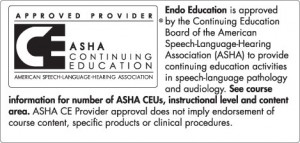International Course on Oropharyngeal Dysphagia
Session#2: Pathophysiology & Clinical Detection of Oropharyngeal Dysphagia
Course Description
Session two begins with a discussion highlighting the role of the interdisciplinary team in dysphagia management. Defining dysphagia and identifying optimal diagnostic tools to identify dysphagia can be challenging in terms of finding unified consensus. Developing a patient-centric treatment approach is critical in a successful regimen. Behavioral rating scales are essential in order to quantify the patients’ perceptions of their impairment and to gauge progress with interventions. The session continues with a discussion of the relationship that exists between respiration and swallowing. Specific nuances relating to parameters of breathing and their suspected impact on swallowing ability are reviewed. The speaker reviews temporal relationships between breathing and swallowing and concludes with discussion on detailed description of normal vs. impaired cough as a pulmonary defense for acquisition of pneumonia. Dr. Molfenter provides a summary of clinical research relating to post swallow residue. She specifically describes a novel technique to measure its severity and explore the relationship between those clinical measures and overall swallow safety. The tool was designed to evaluate levels of residue in the valleculae and pyriform sinus region in relation to the entire available space. Results of the analysis demonstrated a clinically significant relationship between post swallow residue on the valleculae and overall swallow safety. The session continues with a detailed description of how extraction of objective measurement in videofluoroscopic swallowing studies can positively impact patient outcomes. These measurements allow for objective comparison between normal and impaired patients across the continuum of medical diagnoses. The clinical implications for treatment, both surgical and therapeutic are discussed.
Time ordered agenda: 77 minutes
19min 49sec Teaming up to identify vulnerable patients: Catriona Steele, PhD. CCC-SLP, BRS-S, S-LP(C)
16min 02sec Respiration & swallowing: Deanna Britton , PhD, CCC, BC-ANCDS
12min 22sec Post Swallow Residue: Sonja Molfenter , MHSc, SLP(C), Reg. CASLPO
17min 00sec VFSS Opportunities for objective measurement: Rebecca Leonard , PhD, CCC-SLP
13min 32sec Reflections on using the EAT-10 tool for dysphagia screening: Lisa Sokoloff , MS, CCC-SLP, Reg. CASLPO
Learning Objectives
1. Identify patients most vulnerable and susceptible for development of dysphagia.
2. Identify the relationship that exists between breathing and swallowing and the impact of multiple eating-related variables.
3. Describe a new novel method for evaluating post-swallow residuals.
4. Discussion of methods and benefits of objective measuring system in videofluoroscopic swallowing evaluations.
